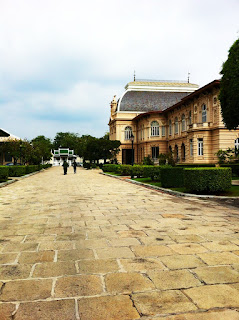 |
| At the Grand Palace |
Here's a few interesting tidbits about this area:
Thailand is the only country in Southeast Asia never colonized by a European power and is sometimes referred to "the land of the free". The Thai monarchy has been in continuous existence since the founding of the Kingdom Sukothai in 1238. King Rama IX (HRH Bhumibol Adulyadej) is the ninth ruler under the Chakri Dynasty since 1782, and is the world's longest-serving head of state and the longest-reigning monarch in Thai history since 1946. He was actually born in Massachusetts while his father attended Harvard University (so, that makes him American by birth?). By law, it is a crime to criticize, insult, violate, or defame the royalty, punishable by imprisonment. Yup. No texting, Facebooking, hypothesizing, etc. about the King out loud.
 |
| Chao Phraya River and Wat Arun in background on west bank |
The history of Bangkok dates at least to the early fifteenth century, when it was a village on the west bank of the Chao Phraya River that eventually grew into the current capital on the east bank of the river under King Rama I. Before most of the canals were filled or built over for city expansion, Bangkok was referred to as the "Venice of the East". The full Thai name of Bangkok is, "Krung thep mahanakhon amorn ratanakosin mahintharayutthaya mahadilok popnoparat ratchathani burirom udomratchanivetmahasathan amornpiman avatarnsathit sakkathattiyavisnukarmprasit" (กรุงเทพมหานคร อมรรัตนโกสินทร์ มหินทรายุธยามหาดิลกภพ นพรัตน์ราชธานี บุรีรมย์อุดมราชนิเวศน์มหาสถาน อมรพิมานอวตารสถิต สักกะทัตติยะวิษณุกรรมประสิทธิ์) and is listed as the world's longest location name by the Guinness Book of Records. In English it means, "The city of angels, the great city, the residence of the Emerald Buddha, the impregnable city of Ayutthaya of God Indra, the grand capital of the world endowed with nine precious gems, the happy city, abounding in an enormous Royal Palace that resembles the heavenly abode where reigns the reincarnated god, a city given by Indra and built by Vishnukarn".
As far as historic places, our visit focused primarily on the two main ones: (1) The Grand Palace and (2) One of the more famous buddhist temples - Wat Po. Home of the Reclining Buddha. These 2 sites are right next to each other in the Old Bangkok, Rattanakosin District. Just when we thought we couldn't take another cathedral, church, or mosque; we have gladly welcomed a whole new level
of architecture and religion to admire!
WAT PO (WAT PHO)
Although Wat Po is home to over 1000 buddhist images, it is famous for one of the largest Buddhas, the Reclining Buddha at 160 meters long. Before the temple was built on this site, it was a center of education for traditional Thai medicine, and statues were created showing yoga positions. Wat Po is known to be the birthplace of Thai massage, which every backpacker in Thailand has enjoyed, at least once! The most intricately designed chedis, stupas, or pagodas house the ashes of at least four prior kings.
After being exposed to all the Islamic tile art throughout Morocco, Spain, Balkans, and Turkey, we couldn't imagine seeing anything more intricate and detailed. Yet, here we stood at the foot of these towering chedis (pagodas) with the most colorful, ornate, and elaborate THREE-DIMENSIONAL artwork covering every square inch of the structures! The Islamic tiles were beautiful but they weren't 3D... A
GRAND PALACE
For over 200 years, the Grand Palace was the country's administrative and religious center, as well as the residence of the royal family. Now, it is largely reserved for royal ceremonial events, some governmental functions, the royal chapel or Wat Phra Kaew (home to the Emerald Buddha), reliquary of sacred Buddhist items, and museum to one of the top Thai attractions.
Below are photos from the Upper Terrace. The gold chedi houses sacred Buddhist relics. The Mondop next to it is a repository for Buddhist sacred scriptures. The building next to the Mondop is the Royal Pantheon where statues of past sovereigns of the Chakri Dynasty are enshrined.
Probably the most revered site is the The Royal Monastery of the Emerald Buddha. The Buddha is carved from a block of green jade and was first discovered in 1434 in a stupa (pagoda) in Chiang Rai. The Buddha is enshrined on a golden throne, and the image is clad in three seasonal costumes that are changed by the King himself. This place serves as the monarchy's private chapel. No photos were allowed of the interior.
The Borom Phiman Mansion below used to be the residence of the royal family, but now, serves as a royal guest house for visiting Heads of State and guests of the HRH.
The Borom Phiman Mansion below used to be the residence of the royal family, but now, serves as a royal guest house for visiting Heads of State and guests of the HRH.
We were most fascinated by the re-roofing work being done on the Phra Maha Monthiam group of buildings. These buildings house the hall where the coronation ceremony takes place (ahem...albeit last one was in 1950!). It also used to be the residence of King Rama I, II, and III, and has become customary for the sovereign to spend at least one night here after the coronation to signify taking up of official residence.
The final group of buildings, The Chakri Group, consists of reception halls of foreign ambassadors and state banquets.
The final group of buildings, The Chakri Group, consists of reception halls of foreign ambassadors and state banquets.























